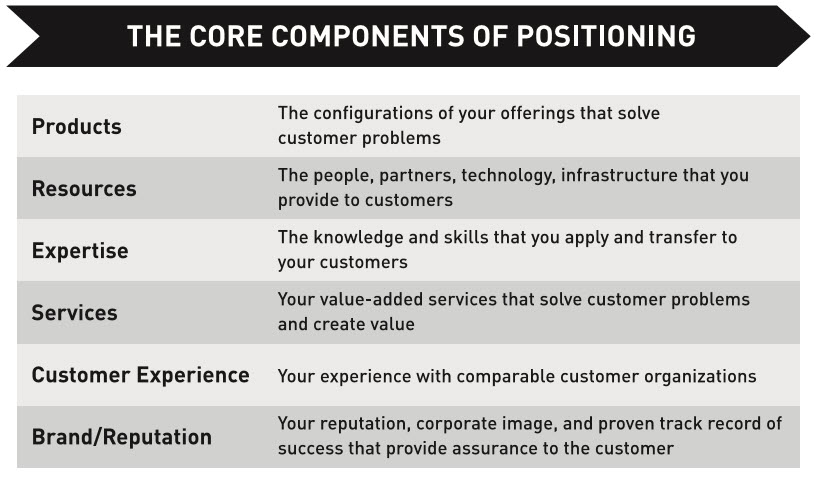Steve Andersen and I are delighted with the acclaim for our new book, Beyond the Sales Process.
We’ve been interviewed a number of times during the past few weeks. One subject that keeps being raised is positioning. So I thought I’d share you you a few short excerpts from Strategy 7 with a graphic highlighting the core components of positioning.

Strategy 7 — Position the Fit: Competing for Customer Mindshare
First, the opening two paragraphs.
In Section I (Before the Sale), you learned how to research your customer and elevate the conversation, focusing largely on possibilities and building a vision of success. In this section, through your discovery, you’ve gained a thorough understanding of the external drivers, business objectives, and internal challenges that are impacting your customer. And through your alignment, you’ve connected your company’s resources to your customer’s team and worked to establish trust and credibility, paving the way for creating and co-creating value.
With positioning, the battle for customer mindshare begins. It’s going to be a struggle, because you and your competitors all want the same thing: to maximize the amount of space that you occupy in your customer’s thoughts and awareness. Capturing the largest possible “share of mind” or awareness won’t happen unless you give your customer valid reasons to think of you in the context of whatever is happening in their world. Effective positioning is precisely how you do it.
From that point we go on to pose, “To Position or Be Positioned? That Is the Question,” and go about providing the answer.
Diagnostic Questions
Next, the six sets of diagnostic questions at the end of the chapter. (There are diagnostics such as these at the end of each of our 12 strategies.)
These are easy questions to ask, but tough for most salespeople to answer. As a competitive sales strategist, these are precisely the kind of questions that enable me to determine where a sales team is on a particular account or opportunity and what must be done to increase the likelihood of winning:
- Does your customer perceive that your solution provides a strong fit for their needs and requirements? You probably won’t win if they don’t. How do you know this? Who on the customer’s team is telling you?
- Do you have, or can you develop, competitive advantage within this opportunity? If so, how will you know? Where is that competitive advantage? Will your customer see it? Will they acknowledge it? Will they value it?
- Does your customer have a vision of a solution, and does that solution include you? (In Section I, we discussed a vision of success; but now you are much more laser-focused.) How do you know? Are you getting direct feedback through ongoing customer collaboration during the sales process?
- Do you have resources available that will enable you and your organization to meet your customer’s requirements and exceed their expectations? This cannot be simply words on paper. If you sell business that you can’t deliver, your success will be short term, and it will probably be the last time you engage with that customer.
- Have you developed an effective proposal that will solve your customer’s business problems and deliver real value? If so, what is that proposal? What are its strengths and where are its weaknesses? Will your proposal meet and exceed the customer’s corporate or department investment policies?
- Does your customer recognize your solution and business value beyond product features and pricing? If not now, then when will they? Are you fully prepared to differentiate yourself from your competition and win this business?
Beyond the Sales Process is a book not about “what” you have to do. There are plenty of those around. This book is about “how” to do it.
Please let me know your thoughts.
